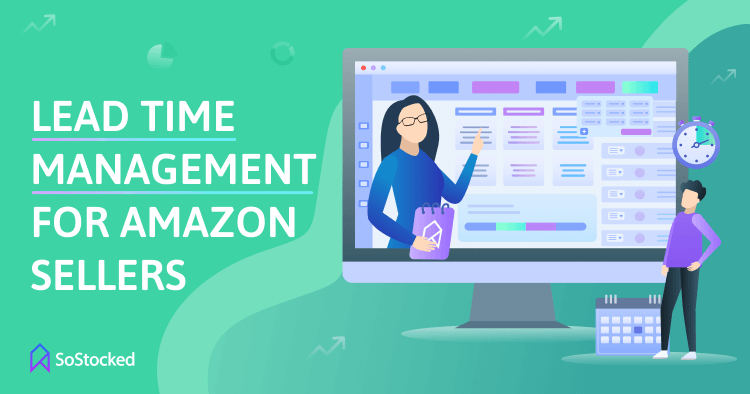
Lead Time In Inventory Management For Amazon Sellers
As one of the core elements of inventory management, lead time can make or break your Amazon business, and its importance towards the overall success of your business cannot be overstated. If you’re an Amazon seller like me, you probably feel as frustrated as I did every time you need to dig through a seemingly endless list of spreadsheets to keep track of orders or to check if you have enough stock to last until your next replenishment.
Well, your days of digging are over. What I’m about to share with you can streamline your entire Amazon inventory management system and help you forecast to demand more easily. You can say goodbye to the disappointment of missed opportunities, stockouts, and to being neck-deep in order forms. Solving these problems and more is why I created my inventory management software for Amazon sellers called SoStocked.
The software features a ton of tools that can simplify the entire inventory management process, such as Order Tracking, customizable Forecasting, and Inventory Reporting Dashboards to streamline your data into actionable tasks. But before I explain any more about SoStocked, and how it helped me address the inventory-related issues in my own Amazon business, it’s essential to grasp precisely what lead time means, how they can help or hurt your business, and what to do to potentially improve them.
In this Lead Time In Inventory Management guide, we’ll take a look at:
What Is Lead Time In Inventory Management and Supply Chain?
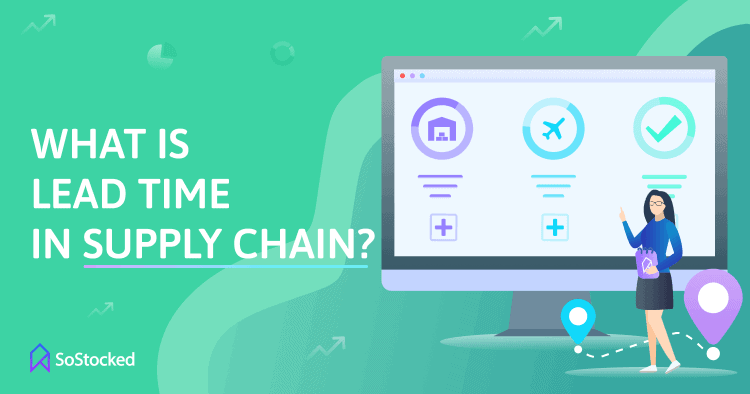
In short, lead time is the time spent between the start and end of a process. Think of it as waiting time. It’s essential to understand that lead time is involved whenever goods are purchased, transformed, or serviced in a supply chain.
For example, let’s say that your Amazon shop sells car gadgets, and you have a supplier called ‘Auto Accessories’ from which you buy cell phone holders. If it takes the supplier 2 days to get the components to make the cell phone holders and 2 more days to assemble 1,000 units, we can say that ‘Auto Accessories’ lead time to produce 1,000 units is 4 days. This means that as a retailer, if you need the products on 4th July, you should place the order on or before 30th June, since you also need to factor in the number of days it takes to receive the good from your supplier.
At first glance, lead time may appear simplistic, but I know through years of experience as an Amazon seller that this is not always the case. Furthermore, I would argue that thinking about lead times is just as important as thinking about future demand. The time we typically count in days, between what you choose to do today and the time it takes for the effect of that decision to be felt, influences how the entire supply chain functions.
Why is Lead Time Important?
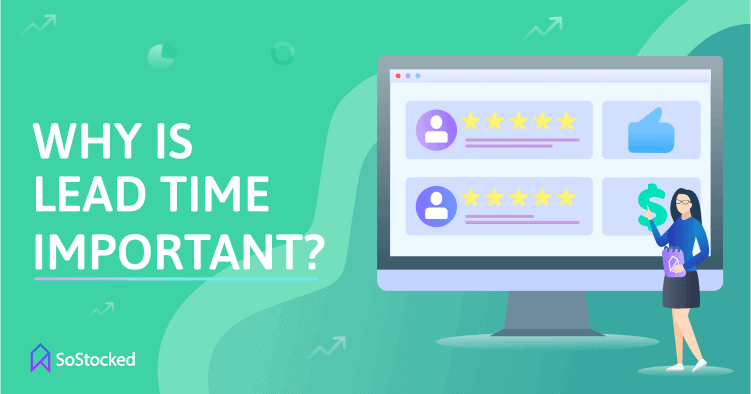
The bottom line is that lead time directly affects customer satisfaction. Typically, customers want goods as fast as possible with minimal effort. If you can manage your inventory efficiently, you will ensure a smooth flow of business.
In the case of stockouts or unavailability of specific products, the repercussions to your business as a whole could be dramatic. Furthermore, if lead times are longer, more advanced planning is needed for seasonality and planned marketing campaigns, as “marketing on a whim” is not as easily achieved with long lead times. To better understand how you can achieve shorter lead times and avoid mishaps, let’s break lead time down into some more manageable components that are easier to digest.
Forecasting
Forecasting stock requirements allows you to prepare for the delay of stock being delivered and avoid potential stockouts. SoStocked’s software will anticipate how much inventory will be consumed between now and the subsequent replenishment, and it also takes into consideration the fact that, while goods are in transit, inventory is gradually being depleted at the same time.
Production
The longer it takes for your goods to be produced, shipped and, finally, available on Amazon, the longer your cash is potentially tied up in products, depending, of course, on your payment terms. If it takes 30 days or more to make and ship your product, every time you reorder, you’re going to need to buy at least 30 days’ worth of product. If you’re selling 5 a day, that’s 150 units, but if you’re selling 20 a day, you need enough cash to buy another 600 units. So, even though your product is successful, you must reinvest more money to buy more stock because the lead time is so long. Hence, it would be best if you did everything possible to reduce the time from order to delivery, and if your lead times are too long, you should consider renegotiating terms with your supplier to ease the cash flow strain created by the longer lead time.
Shipping
Sea freight can take 30 days or more, so if you’re based in the U.S. and ordering from China, you might need 60 days of stock to cover the 30 days that it takes to produce the product and the additional 30 days to ship the product. One way to tackle this is to negotiate with the supplier to send part of the delivery by air freight to speed things up, but in general, I would not recommend air freight if it could be avoided due to the high costs involved.
Competition
If your lead time is too long, your competitor can use that time to get ahead. Suppose one of your competitors suddenly upgrades a feature in their product and starts stealing market share and sales from you; you’re going to need to be able to respond quickly. You don’t want to be stuck with a product that is less competitive in the market because your long lead times kept you from adjusting to market changes quickly enough.
To be more competitive, find out what issues tend to slow your lead time (i.e. supplier getting in raw stock, production delays, etc.) and make a deal to resolve this with your supplier creatively.
For example, you could buy raw stock upfront to have it on hand to speed up production. Another method could be paying 30% upfront for 10K units and then shipping out 2K units at a time and only paying the other 70% for each batch as it arrives at the port, taking advantage of the fact that many suppliers also warehouse inventory for free for up to 3 months, or sometimes longer.
Restocking
If you suddenly get a spike in sales and sell out quite quickly, a long lead time can kill your product if it takes you too long after running out of stock to replenish the product. You could lose your sales to competitors, and furthermore, your BSR could take a hit too.
The important question to ask yourself is: How long does it take to receive inventory from your supplier? If your supplier’s lead time is 10 days, you’ll want to make sure that you place your order at least 10 days before your supply dries up. Ideally, well before then as having a buffer stock, or safety stock, is an important way of safeguarding your inventory from stockouts.
It may be more cost-effective for you to ship larger orders rather than merely ordering the bare minimum of what your sales analysis indicates you should have on-hand.
Cash Flow
The longer the lead time, the more cash that gets sucked into inventory. Even though you’re making a profit, your cash flow might go negative because you have to place new orders for new stock. One way to address this is to make a quick inventory check. Make a list of those products you buy that aren’t moving at the same pace as your better sellers. Slower-moving products can tie up a lot of cash and could hurt your cash flow.
Instead of buying more of what doesn’t sell, sell through it, even if you need to sell it at a discount. It’s hard to walk away from products you fall in love with, hoping that someday you’ll magically see heightened demand, but that rarely happens. Be objective, not emotional.
Break-even and Cycles
If your first order takes 45 days to arrive and then two to three months to really get started selling, you might not break-even for six months or more. On the other hand, if your lead time is only 10 days, you can get going much faster. As I already mentioned, finding creative payment solutions with your supplier to shorten payment cycles, if lead times can’t be shortened, can help to reduce the time it takes to break even.
Instead of buying more of what doesn’t sell, sell through it, even if you need to sell it at a discount. It’s hard to walk away from products you fall in love with, hoping that someday you’ll magically see heightened demand, but that rarely happens. Be objective, not emotional.
Return on Investment
Let’s say you invest $10,000 in stock and it takes four months to sell through; your return on investment will be much smaller than if you could buy $10,000 in stock and sell through in just one month. Effectively, shorter lead times equal higher overall profit and returns due to faster turnover and the ability to avoid monthly recurring storage fees, which eat into your profits. The faster you can turn your cash, the better chance you have of increasing profits and reinvesting what you’ve earned to make more money.
In general, sellers remain committed to their past decisions for roughly the duration of the lead time plus the sell-through period. Understandably, this means that the longer the lead time, the higher the risk if market conditions change.
Now that you have a clearer picture of what lead times are and how they can impact your Amazon business, let’s dig a little deeper.
Lead Time Calculator
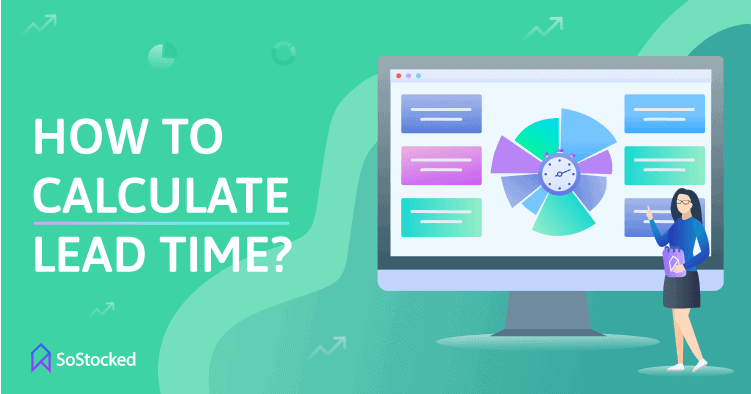
While there are many types of lead times, Amazon sellers are primarily concerned with lead time which relates to the time taken to receive an order from a supplier, which can be calculated using this formula:
Lead Time = Production Time + Shipping Time
or
Lead Time = Production Time + Shipping Time + Check-in Time
When considering the total amount of time for a Purchase Order to be delivered from a supplier, you may need to factor in the time taken to accept and process the order, known as the reordering delay. At times, the reordering delay may already be factored into your supplier’s Production Time, but it’s always good practice to verify this with your supplier.
In SoStocked’s software, the “Order Placed” option under Lead Times should help with this as well as setting orders that are always placed on the same day every month to create predictability with your supplier.
Since lead time directly affects your total inventory levels, the longer it is, the more stock you will need to hold in your inventory. Moreover, longer lead times make deliveries more unpredictable due to unforeseen events like natural disasters, strikes, political unrest, etc., so it’s important not to run too lean before restocking. For this reason, it is wise to have a buffer stock which acts as a cushion in case anything goes wrong.
Once you have done the calculations and know your lead time, the next step is to do all you can to reduce it. If that’s not an option, referring to my advice from the Production and Shipping sections above regarding negotiating better payment terms with your supplier is the next-best solution.
Software For Calculating Lead Times In Inventory Management
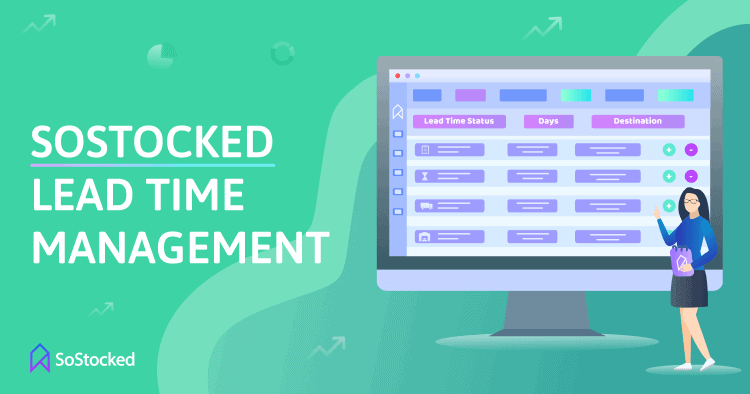
As the first and only fully customizable Amazon inventory management software, SoStocked allows you to oversee lead times in your business on a per-product level. This means you can automate more processes to free up your time, and SoStocked’s platform allows you to track everything all in one place, every step of the way.
Unlike other forecasting providers, the solution is not a one-size-fits-all formula, which never seems to fit all circumstances or requirements. SoStocked has over ten adjustable data points, including stockouts, deep discounts, sales spikes, seasonality, and lead times, for customization that makes for a much more accurate and bespoke forecast.
SoStocked Lead Time Management
As a rule of thumb, it’s best practice when building lead times to set the average time, not a best-case scenario. You can also set a worst-case scenario lead time for busy times of the year when you know your supplier tends to get backed up, such as before the holiday season or before and after Chinese New Year. When it comes to lead times, sometimes the worst-case scenario is the best-case scenario.
To learn how to setup lead times in SoStocked’s software, be sure to check out this informative tutorial for Adding/Editing Lead Times.
At times, it’s vital to know how to prevent yourself from running out of inventory. Sometimes you sell through faster than normal because of an unpredicted sales spike, or you may find yourself facing a stockout due to not placing an order on time. These issues can be solved using SoStocked’s tools in two ways:
- Express Lead Time – an automated solution that can be added to only one product, your entire catalog, or all products from a particular Supplier or within a specific Marketplace, Express Lead Time calculates your fastest shipping methods, such as air freight, to determine how much you need to ship express to stay in stock during emergency situations.
- Split Shipment – offering the same results but with manual control over the input data, you can split any PO into multiple shipments, such as a portion by air and a portion by sea, to ensure inventory arrives before stockout.
Both features are covered in the guide on How to Prevent Stockouts Using the Split Feature.
Setting the right lead times is vital to your business as it determines when the forecasting element of the software will advise you to reorder inventory and further sets the guidelines on how your orders move through the Order Tracker system.
Order Tracker
Used to track your orders along the Inventory Timeline, the Order Tracker kicks in from when the order is placed through production and shipping until it ends up at its final destination. You can learn more about the Order Tracker system by going to the Understanding Lead Times & the Order Tracker tutorial.
Action Items For Managing Lead Times
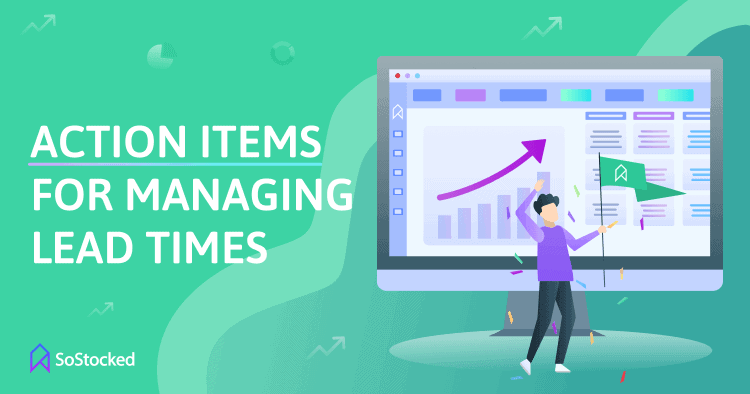
As I mentioned above, lead time is essentially a delay and is a fundamental aspect of all inventory-based businesses. To manage lead time effectively, it’s essential to thoroughly understand the components that constitute lead time and then set about doing what you can to minimize that time.
Setting and adjusting lead times in SoStocked is extremely simply but is key to successfully staying in stock. Getting good at inventory management helps you to make and keep more profit within your business, and that’s really the name of the game after all, isn’t it?
Need more information?
- Send Message: We typically reply within 2 hours during office hours.
- Schedule Demo: Dive deeper into the nuances of our software with Chelsea.
- Join Live Upcoming Webinar: New to Amazon inventory management? Learn three inventory techniques you can implement right away.
 Start Your Free Audit
Start Your Free Audit